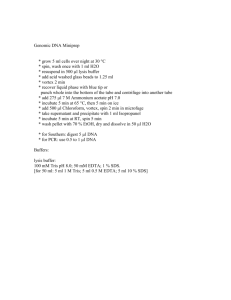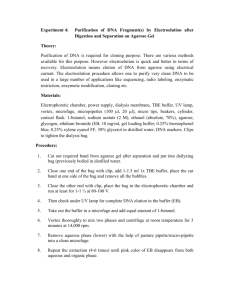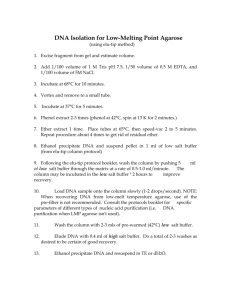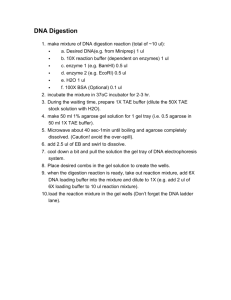Apoptosis DNA fragmentation analysis protocol
advertisement
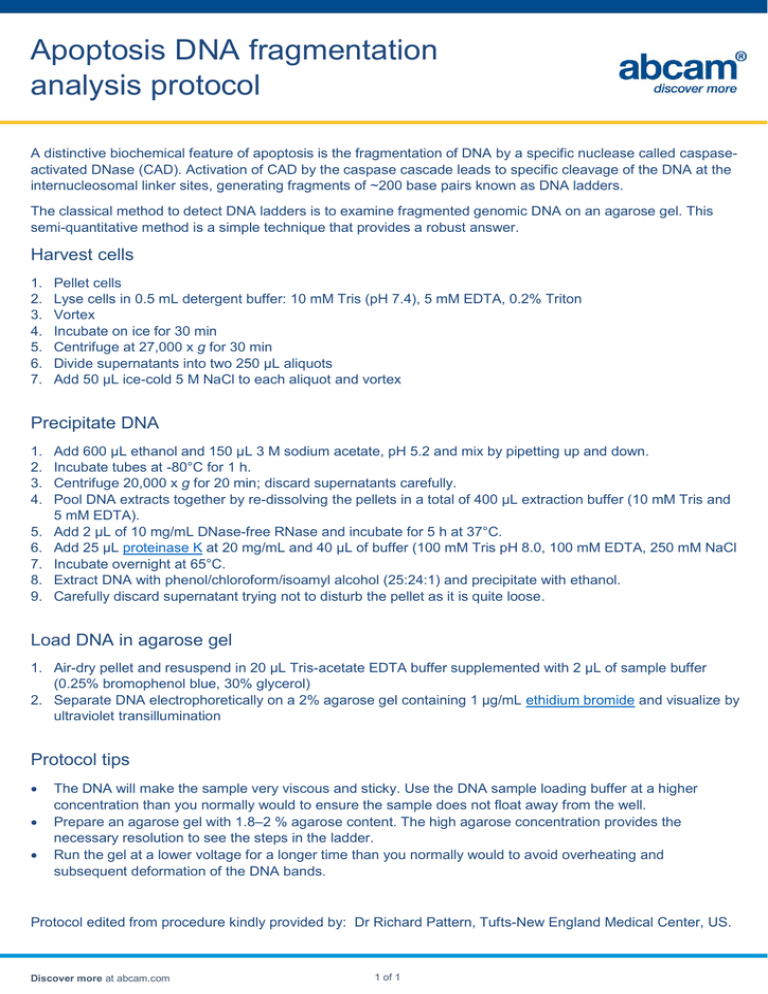
Apoptosis DNA fragmentation analysis protocol A distinctive biochemical feature of apoptosis is the fragmentation of DNA by a specific nuclease called caspaseactivated DNase (CAD). Activation of CAD by the caspase cascade leads to specific cleavage of the DNA at the internucleosomal linker sites, generating fragments of ~200 base pairs known as DNA ladders. The classical method to detect DNA ladders is to examine fragmented genomic DNA on an agarose gel. This semi-quantitative method is a simple technique that provides a robust answer. Harvest cells 1. 2. 3. 4. 5. 6. 7. Pellet cells Lyse cells in 0.5 mL detergent buffer: 10 mM Tris (pH 7.4), 5 mM EDTA, 0.2% Triton Vortex Incubate on ice for 30 min Centrifuge at 27,000 x g for 30 min Divide supernatants into two 250 µL aliquots Add 50 µL ice-cold 5 M NaCl to each aliquot and vortex Precipitate DNA 1. 2. 3. 4. 5. 6. 7. 8. 9. Add 600 µL ethanol and 150 µL 3 M sodium acetate, pH 5.2 and mix by pipetting up and down. Incubate tubes at -80°C for 1 h. Centrifuge 20,000 x g for 20 min; discard supernatants carefully. Pool DNA extracts together by re-dissolving the pellets in a total of 400 µL extraction buffer (10 mM Tris and 5 mM EDTA). Add 2 µL of 10 mg/mL DNase-free RNase and incubate for 5 h at 37°C. Add 25 µL proteinase K at 20 mg/mL and 40 µL of buffer (100 mM Tris pH 8.0, 100 mM EDTA, 250 mM NaCl Incubate overnight at 65°C. Extract DNA with phenol/chloroform/isoamyl alcohol (25:24:1) and precipitate with ethanol. Carefully discard supernatant trying not to disturb the pellet as it is quite loose. Load DNA in agarose gel 1. Air-dry pellet and resuspend in 20 µL Tris-acetate EDTA buffer supplemented with 2 µL of sample buffer (0.25% bromophenol blue, 30% glycerol) 2. Separate DNA electrophoretically on a 2% agarose gel containing 1 µg/mL ethidium bromide and visualize by ultraviolet transillumination Protocol tips The DNA will make the sample very viscous and sticky. Use the DNA sample loading buffer at a higher concentration than you normally would to ensure the sample does not float away from the well. Prepare an agarose gel with 1.8–2 % agarose content. The high agarose concentration provides the necessary resolution to see the steps in the ladder. Run the gel at a lower voltage for a longer time than you normally would to avoid overheating and subsequent deformation of the DNA bands. Protocol edited from procedure kindly provided by: Dr Richard Pattern, Tufts-New England Medical Center, US. Discover more at abcam.com 1 of 1
